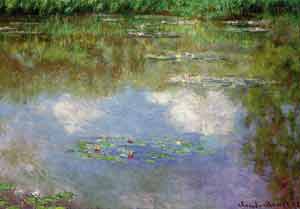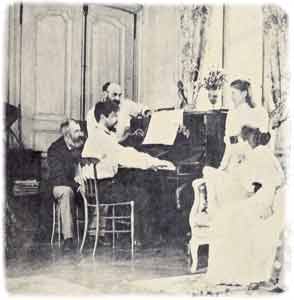The desire to rediscover the lost unity with the world, to perceive the mysterious dimension of the environment that surrounds man and to rebuild its deep vibrations pervade in the sensitivity of Claude Debussy (1862-1918). "Music is a mysterious arithmetic - the French musician wrote- in which the elements participate in Infinity. It is the expression of the movement of the waters, the play of the curves described by changing breezes; nothing is more musical than a sunset." Empathy for the world and its elements make it possible to reproduce the enchantment that is concealed even in the most common phenomenon. It emerges in the simple and yet sublime spectacle of the gentle gliding of a dead leaf, the white frost of a snowy landscape, a golden reflection distorted by the surface of water and the eddies of night-scented air.
Among the material substances that animate natural phenomenon, that which exercises a completely unique fascination for musicians is, without a doubt, water in all of its many forms. Water is a melancholy element that is also sensual, charming, evanescent and striking: during those years it made progress in symbolist poetry and impressionist painting.
In the suggestive titles Debussy gave to his works, the proliferation of extra-musical themes tied to nature and the spectacle it offers, must be noted. Many of these titles are correlated to the variegated phenomenology of the element of air, but even more of them are tied to the image of water: Le jet d'eau, La mer est plus belle, Jardins sous la pluie, Reflets dans l'eau, Poissons d'or, La cathédrale engloutie, Ondine, En bateau, Pour remercier la pluie au matin, Sirènes, La mer, De l'aube à midi sur la mer, Jeux de vagues, Dialogue du vent et de la mer.
References to water are crowded throughout the lyrics of his mélodies for voice and piano. Debussy selected them from the works of many symbolic poets, including Verlaine, Baudelaire and Mallarmé. It becomes a deep metaphor in the melancholic disappearance of the vital drive: in the inexorable descent of natural tropism it becomes that which Huysman defined "the  melancholy element." "The music of Debussy is spongy, wet and dripping," Alberto Savinio wrote. The water that crosses the first chords of the Cathédrale engloutie prelude for piano is dense and immobile. The sounds move slowly in "brume doucement sonore" and they give volume to the musical material making the keys of the piano keyboard resonate throughout its range. The muffled initial sonorities layer and barely filter the distant ringing bells of the submersed cathedral of Ys. In Reflets dans l'eau the light is broken down into motes of golden reflection veiled occasionally by the unsettling fascination of profundity. In the three "symphonic sketches" of La Mer, each energetic impulse finds its balance in the
melancholy element." "The music of Debussy is spongy, wet and dripping," Alberto Savinio wrote. The water that crosses the first chords of the Cathédrale engloutie prelude for piano is dense and immobile. The sounds move slowly in "brume doucement sonore" and they give volume to the musical material making the keys of the piano keyboard resonate throughout its range. The muffled initial sonorities layer and barely filter the distant ringing bells of the submersed cathedral of Ys. In Reflets dans l'eau the light is broken down into motes of golden reflection veiled occasionally by the unsettling fascination of profundity. In the three "symphonic sketches" of La Mer, each energetic impulse finds its balance in the successive analogous one, in a continuous ebb and flow of waves crashing and chasing each other without stopping. At the same time, the enchanting songs of Sirénes pull us from one side to the other, up and down in a hypnotic and encompassing bustle. The sea, the fountain in the park and the stagnant water of the underground keep of the castle articulate the complex symbolism of life and death in the work Pelléas et Mélisande.
successive analogous one, in a continuous ebb and flow of waves crashing and chasing each other without stopping. At the same time, the enchanting songs of Sirénes pull us from one side to the other, up and down in a hypnotic and encompassing bustle. The sea, the fountain in the park and the stagnant water of the underground keep of the castle articulate the complex symbolism of life and death in the work Pelléas et Mélisande.
"Claude Debussy is the musician of sleeping and stagnant waters," according to Jankélévitch, "just as Claude Monet is the painter of them; on an equal footing with the composer, of Water Lilies, he watches over the veining, the calm opalescence and iridescence that tremble on the mirrored surface of the greenhouses." Monet worked on the variations and the effects of light and specifically on its reverberation and the reflection in the water. The study of water offered a pretext for representing unformed masses animated solely by rich shading.